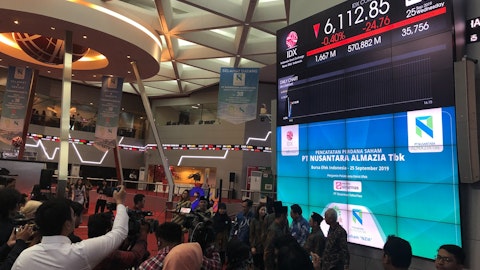PagerDuty, Inc. (NYSE:PD) Q4 2023 Earnings Call Transcript March 15, 2023
Tony Righetti: Jennifer Tejada, PagerDuty’s Chairperson and Chief Executive Officer and Howard Wilson, PagerDuty’s Chief Financial Officer. Before we begin, let me remind everyone that statements made on this call include forward-looking statements based on the environment as we currently see it which involve known and unknown risks and uncertainties that may cause our actual results, performance or achievements to be materially different from those expressed or implied by the forward-looking statements. These forward-looking statements include our growth prospects and future revenue among others and represent our management’s belief and assumptions only as of the date such statements are made and we undertake no obligation to update these.
During today’s call, we will discuss non-GAAP financial measures, which are in addition to and not as a substitute for or superior to measures of financial performance prepared in accordance with GAAP. A reconciliation between GAAP and non-GAAP financial measures is available in our earnings release. For further information on these and other factors that could cause the Company’s financial results to differ materially are included in filings we make with the Securities and Exchange Commission, including our most recently filed Form 10-K and 10-Q, as well as our subsequent filings made with the SEC. With that, I will turn the call over to Jennifer.
Jennifer Tejada: Thanks, Tony, and thanks, everyone for joining us today. We delivered a solid fourth quarter and another strong year in FY2023. We are demonstrating durable and now profitable growth through significant product innovation and disciplined go-to-market execution. Revenue grew 32% year-over-year, and we added 379 net new customers to our platform during FY2023. We achieved non-GAAP profitability one-year ahead of plan with an operating margin of 1%, up 900 basis points over FY2022. For Q4, we exceeded the high-end of both our top and bottom line guidance ranges. Our Q4 revenue was $101 million, up 29% over the previous year, and our first quarter surpassing the $100 million revenue milestone. We also surpassed $400 million in annual recurring revenue through a combination of ongoing product leadership in digital operations and our multi-year focus on winning in enterprise and mid-market.
We ended the year with 68 of the Fortune 100 and nearly half of the Fortune 500 relying on PagerDuty to modernize their operations where we continue to see significant expansion opportunities. Dollar-based net retention was 120%, our ninth consecutive quarter at or above that level. We exited Q4 with 752 customers contributing more than $100,000 in ARR, up 27% year-over-year. We continue to see high engagement from our customers with a record number of mid-market and enterprise transactions in the quarter. Non-GAAP operating margin was 6% as a result of accelerating strategic initiatives to sustainably improve our cost structure. While we executed well in an increasingly difficult macroeconomic climate, we saw customers exercising more diligence and adding approval levels for medium to large deals.
This has resulted in sales cycles elongating each of the past three quarters and transaction sizes decreasing. While annualized churn remained well below 5% of starting ARR, we experienced elevated levels of churn from small and medium sized customers in Q4. In some cases, customers acquired seats in line with, but not ahead of current needs. From a new customer acquisition perspective, tighter budget management and more restrictive buying authority added increased friction to landing new accounts, particularly in SMB. We’ve adapted to these dynamics in two principle ways. First, we have sustainably improved our cost structure to scale more efficiently and profitably while investing in platform differentiation that widens the competitive gap.
Second, we are successfully engaging customers with a comprehensive operations cloud value proposition to help them optimize their operating efficiency and to streamline their technology ecosystems. As a result, platform opportunities now make up a higher mix of our total pipeline than a year-ago. Our product development teams increased our new product velocity meaningfully in FY2023 with several newly available products released that positioned PagerDuty for further expansion across enterprise customers. Some of our major new releases that leverage AI or automation include Incident Workflows, Event Orchestration for AIOps, Automation Actions, and Status Pages, as well as a comprehensive customer service offering. We continue to expand our ecosystem with over 700 integrations.
Earlier this year, we made Incident Workflows generally available to PagerDuty customers. This unlocks flexibility for our customers, leveraging technology from our acquisition of Catalytic, using no-code workflows, so teams can rapidly customize for specific business team and operational needs. Incident Workflows automate work, minimize human error, and empower our customers to immediately capture tangible ROI across a wider range of operational needs. We also launched PagerDuty Status Pages during the quarter, enabling users to securely communicate real-time operational updates directly from the platform to end customers, as well as to key stakeholders across the business. Status Pages leverage both Event Orchestration and Incident Workflows to create a single source of the truth and automatically post detailed updates saving time during an incident response.
Unlike other Status Pages solutions, PagerDuty eliminates the need for multiple tools, reducing costs. Many PagerDuty customers have added Status Pages to their accounts and replaced less integrated and less automated point solutions. In February, we released the Customer Service Operations application for ServiceNow Customer Service Management. Building on a popular integration, the application enables seamless collaboration between customer service agents and engineering teams. PagerDuty customers can drive trials of this new application inside the platform leading to efficient product discovery and reduced friction for expansions. In addition, we delivered many platform wide initiatives, which continued to improve the reliability and security of our platform and made progress on the path to FedRAMP certification.
All new launches are tightly integrated, creating compounding value for PagerDuty customers with comprehensive deployments. Looking ahead to our FY2024 platform roadmap, we expect to continue investing in a high rate of innovation across the Operations Cloud. We will build on our workflow automation, expand our AIOps offering, further enable distributed process automation, and add additional flexibility to design workflows for customer service teams and other business operations use cases. I want to thank our product and engineering teams for one of our most productive, innovative years to date. Our go-to-market teams also executed well, despite a tougher demand environment evolving as the year progressed. During the year, we launched PagerDuty Japan, standardized our global go-to-market model, and advanced our product partnership with AWS.
Our TAM remains expansive and our go-to-market teams are realizing economies of scale. Customers remained very engaged throughout the year, and we closed a record number of customer transactions in both Q3 and Q4. ARR per customer continues to grow, which has been a consistent trend, up 23% for the year. We continue to see enterprise customers in highly regulated industries derive significant efficiency from the operations cloud, maintaining security and compliance, even as they reduced incident duration, volume and noise while increasing their productivity. This quarter, a Global 500 North American Consumer Bank signed a six-figure expansion, including our largest customer service operations deal of FY2023. The customer also added process automation and expanded their incident response deployment.
They now invest over $1 million in annual recurring revenue with PagerDuty and are actively evaluating our AIOps solution. By partnering closely with the CTO, we aligned on priority operational outcomes for the year. PagerDuty has become the bank’s strategic partner for modernizing their operations. We conservatively anticipate an initial ROI of over 300% with a payback period of as little as three months. A leading provider of cloud-based enterprise software for payroll, human resources and financial management has been a PagerDuty customer since 2015. In the fourth quarter, they signed a seven-figure, three-year expansion agreement. They now pair PagerDuty’s incident response with Automation Actions, Process Automation, and Customer Service Operations.
They utilize the PagerDuty Operations Cloud to manage major incidents across their global business, minimize impact to customers, and maximize operational efficiency with automation. In Q4, we closed a six-figure expansion with a European-based food delivery marketplace. The company has been a PagerDuty customer since 2013, but had previously been utilizing multiple solutions in addition to PagerDuty. Last year, in an effort to standardize IT solutions globally and reduce their infrastructure costs, they decided to standardize on PagerDuty. In addition to retiring point solutions, they are adopting our Operations Cloud platform. Our first value is champion the customer, putting our users at the center of our innovation, building great products and making things easy.
Part of championing our customers means building an equitable company that reflects the global and diverse users, customers, and communities we serve. In FY2023, we advance the efforts of PagerDuty.org by launching both our climate equity portfolio and the PagerDuty impact accelerator to deliver product, volunteer, and financial support to mission-driven organizations. We also continued to build on our inclusion, diversity, and equity programming. In Q4, we released PagerDuty’s third annual ID&E report, tracking our progress and sharing our path forward. In FY2023, we increased the number of underrepresented people and women in our senior leadership, including technical leadership. We achieved gender pay equity worldwide and are within a single cent between majority employees and underrepresented groups in comparable roles.
These improvements are both the result of systematic focus and an expression of deeply held values across the PagerDuty team. While we are proud of our progress, we acknowledge we have more work to do. I encourage you to read the full report on the website. Organizations of all types need to modernize their operations in the face of rapid digitization. The cost of interrupt work and disruption has never been higher. Ticketing and queued solutions fail to address the complex nature of modern digital operations. Our customers continue to demonstrate their need for greater efficiency and faster paths to value, choosing PagerDuty as their long-term strategic partner and the Operations Cloud as their platform for engagement. While macroeconomic conditions continue to evolve in the near-term, our long-term tailwinds, digital acceleration, DevOps transformation, and cloud adoption continue to be multi-year imperatives for our customers.
We are confident in our long-term opportunity, and as such, we will continue to invest behind our strategic priorities while improving our operating margins. We are still early in a large market and we remain focused on building a durable and profitable growth company. Our innovation has strengthened our competitive advantages and brought several new products to market that we have begun to monetize. Our high levels of customer loyalty are validated by our net retention and continued growth of customers spending more than $100,000 annually. PagerDuty is the platform businesses rely on, to produce seamless digital experiences, maintain their digital infrastructure and free capacity to focus on innovation. I’m inspired by our customers, energized by our teams, and confident in both our ability to navigate near-term challenges and to execute on the long-term opportunity ahead of us.
Thank you to our team, to our customers, and to our partners for your dedication, your work, and your loyalty. With that, I’ll turn the call to Howard and I look forward to your questions.
Howard Wilson: Thank you, Jen, and good day to everyone joining us on this afternoon’s call. Our fourth quarter and fiscal year results demonstrate durable, profitable growth driven by customers continuing to rely on the PagerDuty Operations Cloud to reduce costs, protect revenue, and retain talent. And what continues to be a tough macroeconomic environment, we noted strong retention and a high volume of customer transactions. And as a company, we continue to make progress on our profitability goals being profitable on a non-GAAP basis for the full-year. Unless otherwise stated, all references to our expenses and operating results are on a non-GAAP basis and are reconciled to our GAAP results in the earnings release that was posted before the call.
Revenue was $101 million in the fourth quarter, up 29% year-over-year. The contribution from international was 24% of total revenues and unchanged from Q4 of last year. We delivered dollar-based net retention in Q4 of 120% compared to 124% in the same period one year-ago. DBNR has been at or above 120% for nine consecutive quarters. However, based on customer data from the second half of FY2023, we are modeling a range of a 117% to 120% in FY2024 with Q1 being at the low-end of the range. Customers spending over a $100,000 annual recurring revenue grew to 752, up 27% from a year-ago. Total paid customers increased by 3% annually to 15,244 compared to 14,865 in the year-ago period. Consistent with the macro in the small, medium business segment, we had slower acquisition and elevated levels of churn, which slowed total paid customer growth.
Free and paid companies on our platform grew to over 24,000, an increase of approximately 20% compared to Q4 of last year. With over 80% of our ARR coming from the enterprise and mid-market segment, we will continue our focus on paid customer acquisition in these segments and leverage our free offering in SMB. As a result, we expect total paid customer growth to be in a range of 5% to 10% in FY2024. In terms of metrics that we provide on an annual basis, customers with ARR over a $1 million increased to 50, up 16% compared to Q4 of last year. ARR from customers using two or more paid products was 58%, 1 point lower than FY2022, and up from 49% in FY2021 and 29% in FY2020. Please note that the numbers shared on this call were derived at the customer level, which is consistent with our paid customer calculation.
On last year’s fourth quarter call, we presented numbers at the account level. And we exited Q4 with $410 million in annual recurring revenue, which was an increase of 26% year-over-year. Q4 gross margin of 86% remained within our target range of 84% to 86%. Operating income improved to $6 million or 6% of revenue compared to a loss of $2 million or 3% of revenue in the same quarter last year. The annual improvement was driven by sustainable sales and marketing efficiency gains and economies of scale across G&A and the quarterly improvement was as a result of our long-term operations efficiency initiatives. In terms of cash flow for the quarter, cash from operations was $18 million, and free cash flow was $16 million. For the full fiscal year, revenue was $371 million, up 32% year-over-year, and a similar growth rate as FY2022.
Gross margin was 85%, relatively flat year-over-year. Operating income was $3 million or 1% of revenue compared to a loss of $23 million or 8% of revenue a year-ago. Operating cash flow was $17 million compared to negative $6 million a year-ago. Free cash flow was $9 million compared to negative $13 million in fiscal 2022 and headcount increased to 1,166, up 23% year-over-year. Turning to the balance sheet. We ended the quarter with $477 million in cash, cash equivalents and investments. Total deferred revenue ended the quarter at $209 million, up 23% year-over-year. Quarterly calculated billings were a $130 million, which was an increase of 23% year-over-year ending above the guidance of approximately 20% provided during last quarter’s call.
This result includes approximately $3 million in prepaid multi-year billings. Adjusting for this, the increase was 21%, and also above the guidance. We expect billings growth for Q1 to be approximately 20%. Given quarter-to-quarter fluctuations in billings, we focus on trailing 12 months billings. On a trailing 12 months basis billings were $410 million, an increase of 27% compared to a year-ago and above the rate provided during our last call. As a reminder, the comparable period Q4 of FY2022 included a one-time benefit of approximately $2 million from early renewals. We expect trailing 12 months billings growth exiting the first quarter to be approximately 24%. In providing guidance, we are factored in the current macroeconomic environment, which from a topline perspective manifests itself in longer sales cycles on larger deals and increasing volume of smaller purchases, general conservatism in spending, particularly for new projects and increased challenge for small and medium businesses.
For the first quarter fiscal 2024, we expect revenue in the range of $102 million to $104 million, representing a growth rate of 19% to 22% and net income per diluted share attributable to PagerDuty, Inc. in the range of $0.09 to $0.10 with fully diluted shares outstanding of approximately $104 million. This implies an operating margin in the range of 6% to 7%. For the full fiscal year 2024, we expect revenue in the range of $446 million to $452 million, representing a growth rate of 20% to 22% and net income per diluted share attributable to PagerDuty Inc. of $0.45 to $0.50 with fully diluted shares outstanding of approximately $105 million. This implies an operating margin of 8% to 9%. Before moving to questions, I would like to provide assistance with modeling FY2024.
We expect non-GAAP gross margin to be in our target range between 84% and 86%. Q1 cash outflows include a one-time severance payment of $5 million and seasonal payments related to our short-term incentive plan and for Q2, interest on our convertible debt. Q2 expenses will include the first full quarter of annual merit increases. With respect to free cash flow, the second half is expected to be higher in terms of free cash flow margins. And for the full-year, we expect free cash flow margin to be at least a couple of points better than our operating margin. And what is been an uncertain economic environment, I would like to thank our customers for their continued partnership. Our expanding Operations Cloud offerings that help our customers transform critical work, our high retention rates and demonstrated operational efficiency put us in a strong position this year to continue with revenue growth above 20% and expand our operating margins significantly.
With that, I will open up the call for Q&A.
Operator: Okay. Thank you, team. And we do have hands raised for questions already. Let me bring Jennifer on with us. And we’ll turn first to Sanjit Singh with Morgan Stanley. Sanjit?
Sanjit Singh: Thank you for taking the questions and congrats on a solid end to the year and on the outlook, very impressive on the margin guide. I’m happy to see that as well. When you look at the full-year outlook, Howard, and given that you saw elevated churn on the SMB and remind me, I think it was about it was around 20% of ARR. How much of that churn is a headwind going into next year when we look at the full-year guide?
See also Top AI Healthcare Stocks to Buy and 10 Penny Stocks that will Make You A Millionaire.
Q&A Session
Follow Pagerduty Inc. (NYSE:PD)
Follow Pagerduty Inc. (NYSE:PD)
Howard Wilson: Thanks, Sanjit. So you’re right, so SMB represents about 20% of our revenues. We have contemplated that in fact that into the guidance that we’ve given for this year. So we’ve modeled in similar levels of movement within SMB, both in terms of new customer acquisition and downgrade and churn.
Sanjit Singh: Makes sense. And then just one more question on sort of the outlook, because I was really happy to see the 20% plus revenue growth, and that’s on the question of layoffs and we continue to see big tech announce pretty sizable layoffs. And what’s the sort of update on the assessment there? Are engineers still finding jobs relatively quickly in terms of and then potentially coming back to PagerDuty if they leave the company and go on to the next one?
Jennifer Tejada: Yes. I’ll take that question. Nice to see you, Sanjit. Look, we’re very confident in our top and bottom line guide. We’ve given a lot of thought to the macro, and while we have seen layoffs, what I would say is we continue to see most of those layoffs outside of engineering, and if anything, what we’re finding is the incident response has become more important because our customers are looking to help their engineers do more with less, improve their productivity, and in fact, decrease the cost of their infrastructure. So we’re at right platform at the right moment in this current market environment. And no question has it been a tough environment that’s had some impact, but our team is executing very well and executed through the pandemic very well. So we have a high degree of confidence that we can deliver on our guidance even if this macro environment persists and if it were to improve, we would see that as upside.
Sanjit Singh: Great. Thank you so much for the thoughts and congrats on the outlook.
Jennifer Tejada: Thank you.
Howard Wilson: Thanks, Sanjit.
Operator: Thanks. Next, we’ll turn to Matt Hedberg with RBC.
Matthew Hedberg: Great. Thanks for taking my questions guys. Congrats from me on the results. And especially the free cash flow guide, Howard, I think that’s really, really excellent. Jen, yes, I want to start reviewing from a high level perspective. There’s been a lot of talk obviously about Generative AI and you guys have had a longstanding focus on AI in general. Can you give us your perspective on what Generative AI might mean for the PagerDuty platform going forward?
Jennifer Tejada: Well, for sure, AI has been a mainstay alongside of automation in every part of our platform, and it’s an area that we continue to invest in. I think one of the places where we were early was in building a foundational data model to support our customers in moving from simply responding faster to issues as they arise, to actually proactively preventing those issues from becoming major customer impacts. And that has been through leveraging AI in incident response, in AIOps, in parts of our automation product, and increasingly in customer service. Generative AI, right now we see it used for a lot of content creation. It’s dependent on a large model, the Internet being one of those. But one of the challenges for Generative AI in our space is our customers expect a very high level of fidelity in the signals that they get false positives or false negatives are not good things when you’re dealing with business critical or mission critical infrastructure.
And so I think it’s going to take some time to determine where the right role for Generative AI is in the product per se. But you can imagine, shortening efforts in diagnostics, reducing the time that it takes to know which service is a root cause or how to remediate, et cetera, and we’re experimenting with some of those things. But from an analytical AI perspective, I still think the data set that we have puts us in a very good position to continue to use AI, machine learning across the platform to automate some of these big challenges when our customers are looking for productivity and efficiency above all else.




